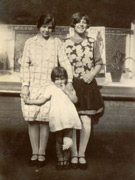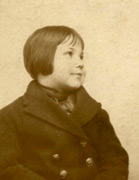 |
| Edna, myself and Eva outside the fish and chip shop. |
The first floor had a lounge at the front, and a large bedroom at the back, which was kept for visitors. The top floor had two more large bedrooms which were used by our family. Every bedroom had chamber pots, and wash bowl with a water jug. Each day they all had to be emptied and cleaned, and the water jug refilled. There was also a drinking water carafe in each room, and over their necks was an inverted tumbler. The shop was very well placed as we were opposite the The Imperial Cinema from where filmgoers would very often come for fish and chips to eat on their way home.
Mother, who was a very good cook, was asked by many customers and friends if she would start making meat pies to sell, and she agreed. These pies became very popular, and eventually three small tables were set-up in the shop so that customers could sit and eat hot pies with chips and peas. At this time my sister Edna started to work with my father in the shop where things were getting very busy. During this time my father would often take me with him when he went to his fish-merchant or potato-merchant, when he paid his bills or made fresh orders. These visits I really enjoyed because I was given treats. I remember I liked the potato merchant best as he would give me a paper carrier bag when we got there, and as we walked around the warehouse he would hand me apples, pears, bananas and other goodies to take home.
 |
| The infants at Queens Road School c1929. I'm standing at the back left. |
In the infants class at my school the pupils were allowed to rest at the start of the afternoon classes, but there were 20 children in this class, and there were only eight camp beds to share between us. However, the teacher was very smart, and she told us "sit up straight in your chairs", and then she would choose eight children to rest on the beds for 60 minutes. The remainder of the children would have to go to sleep with their head on crossed arms on their desk. If we woke before time, we were allowed to look at books or to draw.
At this school the birthdays of the children were mentioned in class and two other children shared the 24th of May with me. This day was still celebrated as Empire Day, and we three were allowed to take part in the special parade in the school, where we had to carry samples of food, silks, wool etc, to remind us of the things we had from the countries of the Empire. At the Empire Day celebrations all the pupils in the first three classes were given a Union Flag (Union Jack) to carry.
I enjoyed my days at this school, and made many friends there, some long lasting. Three of these friends had parents who also had shops in Wilford Road. Audrey's family had a thriving shoe shop, Grace's family had a busy butchers shop, and Mary's family had a very good hardware shop.
My first visit to the cinema without a grownup relative was to see the "Saturday Film Show for Children", at the Imperial Cinema. This cinema was just across the road from where we lived so I managed to go quite a few times.
Another of my pleasures was to be taken to Wollaton Hall in Nottingham which had a large park with a lake, and lots of grassy slopes where fun could be had by playing "rolling down races" with other children. The Hall itself was Elizabethan and very beautiful. The public were allowed to go inside to see paintings, carvings, stuffed animals, and glass covered cases of beetles, butterflies and moths etc, the later being my favourite. As I was then still quite small I was often handed a small stool and a large magnifier to use, and I was fascinated by it all. Just outside the Hall was an oubliette, where I could stand on the grill to look down into the one man prison.
I also enjoyed going to Nottingham Castle, which was built on top of a hill. At that time the view from the top of the castle was very wide and interesting. Inside the castle was a museum with paintings, military dress and equipment, books and documents etc. Most of the children enjoyed going to the castle because of its association with the stories of Robin Hood.
Not far away from home was the River Trent, where we would sometimes take a picnic to eat whilst sitting on the sloping bank, or on the steps by the river. I used to enjoy throwing bread to the fish in the river. The stretch of road by the north side of the river from Wilford Toll Bridge to West Bridgeford Bridge was called The Victoria Embankment and between these two bridges was built one of the first suspension bridges for pedestrians. The Embankment side led to the Memorial Garden which had fishponds and a paddling pool for children. It was fun going there, and yes I did fall in at least once! From Easter time until late September pleasure boats would ply the River Trent, from Wilford Toll Bridge via West Bridgeford to Colwick Weir.
Sometimes we would take a picnic bag and walk from home, go over the Wilford Toll Bridge to the grassy riverside in Wilford village, which was a mile or so away. The toll to be paid if you walked over the bridge was a half-penny each way, or you could go over three or four times a day if you paid a penny on your first crossing. If you bicycled it cost one penny each way or two pence for four times. To park your cycle at the Toll House each day, cost six pence for four days, and motorbikes cost double this rate. To drive a car over was six pence.
 |
| Me at 4 years old with short hair, in my navy reefer jacket which had brass buttons. |
We often used the regular tram service. This ran every day from the Toll Bridge into Nottingham, then onwards to Carlton. My uncle, Alf Justice, was a tram driver at this time, and whenever he drove past our shop he would 'clang' the tram bell, which was really used as a warning to other road users. Later when double-decker buses were used he would sound the horn as he passed.
One of the reasons for using the City Transport was to get to the washhouse. We had to go there every week to do our laundry as we had no facilities at home to do this. Sometimes I would go with my mother to 'help' but I was usually bored. It was a large Victorian building with very high ceilings, and cold stone floors which could be easily mopped over. At each sink we had to stand on wooden duckboards to keep our feet dry. There were 20 or 30 large sinks for washing and rinsing, about six heavy wringers with wooden rollers, and 20 or 30 large and heavy pullout driers each with five rails. Each sink had a number, so you had to use the dryer with a matching number. When the clothes were dry enough you could use one of the many flatirons. To get everything done would take most of the day, so we had to have enough food and drink with us. I remember that we would carry the clothes there and back in a large straw-plaited expanding laundry basket, which had two leather straps and a handle. I used to feel very sorry for my mother who had to carry this heavy basket to and from the tram. I am sure she must have enjoyed the journey back after she had been on her feet most of the day.
 Home
Home